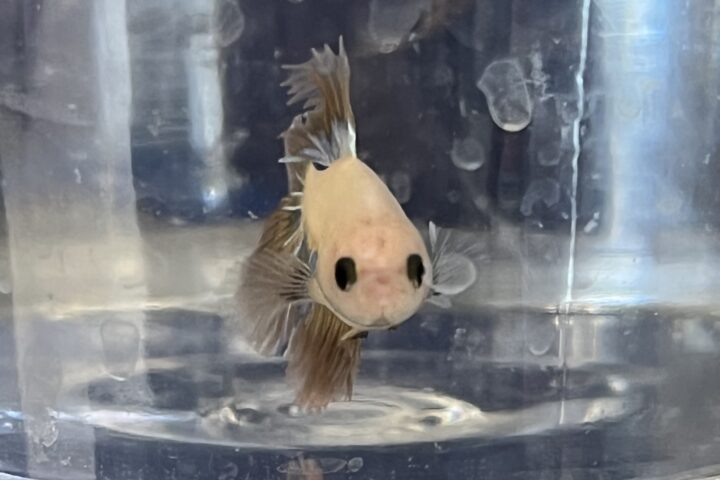By Ryanne Slagiel
In college dorms, your options for furry friends are often limited. Pets can be great—especially in giving you an outlet, a hobby and a friend outside of work and school. In the CI dorms especially, though, your pet options are slim. One great option though is a scaly friend—a betta fish.
Though advertised as an easy beginner pet, betta fish are not quite as hearty as they are promoted to be. When you hear the stories of betta fish surviving in puddles in the wild, it gives you a preconceived notion that bettas can survive and be happy anywhere. But surviving does not equal thriving. With that in mind, here is how to make sure your little betta buddy is thriving!
The first thing you need to consider once you have decided to get a fish: tank size. For a single betta fish, you need to have at least two and a half gallons for survival. No vases! For optimal betta happiness, though, five to 10 gallons is preferred. Bettas are relatively bigger fish in terms of the fishkeeping game, and they need lots of room to swim around! This goes doubly if you have a fish with those beautiful trailing fins—they need room to stretch out. Your betta fish should not be cramped at all. Additionally, you never want to keep your betta in a curved tank or a bowl—for several reasons.
Bettas, also known as Taiwanese fighting fish, are extremely aggressive towards other fish; this is especially relevant in two male bettas. You never want to house two male bettas together (while females can be housed together in a “sorority,” this requires a large amount of fishkeeping knowledge and skill), and you never want to put a male betta in a situation in which he can see his own reflection. Should he be in that situation—whether it be him seeing his own reflection on curved glass, or it’s one of those terrible “exercise” mirrors they sell at pet stores—he may end up trying to fight himself, resulting in injury or death. Curved tanks can also stress your fish out; it alters their depth perception and makes them think they have more room than they do.
Next on your “to buy” list, you want to think about your filter. You want your filter to roughly match the number of gallons on your tank—so get a five-gallon filter for a five-gallon tank. There are different types of filters—you are likely going to want a gentle filter with adjustable settings. The best ones I have found have all been side-hanging “waterfall” style. Be careful with the ones that are fully submerged in the tank, though, as your bettas might get curious and swim into the filter. Typically, your bettas will be fine after this, if a bit shaken, but to avoid this, block off large entrances with a sponge or other water-safe item (I used a large bottle brush for mine!). If your filter does not move the water around, you will also want to invest in an air pump. This will make sure your betta survives—betta fish do not breathe water; they breathe the oxygen above and in the water.
The last important item to have for a betta’s survival is a heater. Betta fish ideally need to be between temperatures of 78-80°F. In the wild, betta fish live in the warm Southeast Asian waters, and thus acclimated to tepid water parameters. It is important not to let your water get too cold, or your betta’s metabolism will slow down, they will become lethargic, and eventually they will die.
There are also smaller things that would benefit your bettas but are not all the way necessary for survival. Water test strips are extremely helpful to knowing whether your water is safe for betta inhabitation, as are temperature strip stickers or even a floating thermometer. Things like an algae scrubber and a siphon will make water changes—the requirement of changing about a third of your betta’s water with pre-conditioned water, either store-bought or homemade with water conditioner drops—much easier, but are ultimately unnecessary, as their primary functions can be fulfilled with items like credit cards and turkey basters.
Finally, you can start decorating your tank! You want to start with substrate, usually gravel, and rinse it until the water runs clear. That will serve as the “base” for the rest of the decorations—after that, it is your choice. Bettas typically enjoy dark places to hide and spots near the top of the tank to laze about; false leaf hammocks are popular for this purpose. Do not give them anything with sharp or jagged edges, as their long fins make it easy for them to get caught on things and injured. For plants, it is better to opt for real ones, but silk plants work as well. Get creative with your decorations and give your bettas adequate mental stimulation.
Bettas typically should be fed twice a day, with a weekly 24-hr fast. You will also want to make sure the clean organic matter and debris from the tank on a regular basis, and make sure you interact with them! Bettas are smart, and they get lonely.
If you follow this guide, your new scaly friend will be happy, healthy, and thriving. You are ready to pick out a buddy!

